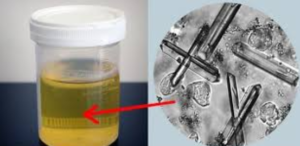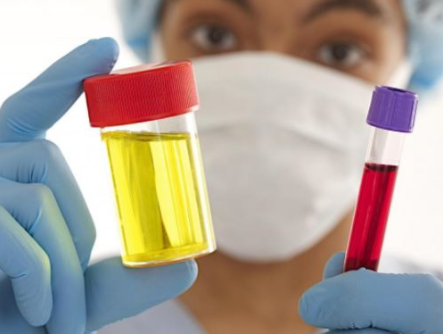Crystals in urine could mean a number of things. In human it could be a sign of an underlying health condition such as dehydration, kidney stones, and changes in pH value or urinary tract infection. Find the causes of this condition in dogs, cats and humans, as well their symptoms and natural treatment.
Urine comprises of water and various chemical compounds that are produced in your body as waste materials. Your kidneys are responsible for filtering the waste products from your blood and then separating urine, before sending it to your urethra. But, there are cases where crystals in urine are noted.
When you closely examine the urine of an individual who is healthy, you are likely to see few crystals in urine. If you notice the presence of too many crystals in the urine, it means that the individual could be suffering from underlying medical conditions. Urine crystals come about due to:
- Urinary tract infections
- Dehydration
- Changes in the pH value
- Formation of kidney stones
It is possible to do away with the crystals by making slight changes in your diet. Below, we are going to look at crystals in urine causes, meaning, symptoms, what causes urine crystals in a dog, cat, home remedies, and recommended natural treatment
Crystals in urine – what does it mean?
If you notice needle fan or wheat shaped crystals, you should immediately start thinking of sulfur crystals. They form due to administration of antibiotics containing sulfa. If you notice hexagon shaped crystals, then it means that you are dealing with cysteine crystals. They come about due to an inherited disorder.
Uric acid crystals come in varying in shapes and sizes and are normally found in acidic urine. The crystals have shapes that may resemble rosettes, parallelograms, and rhomboids. They are often amber in color and could indicate a serious underlying destructive process brought about by cancer treatment.
Urine crystals in Human
The primary function of your kidneys is to filter your blood and produce urine, which as mentioned earlier is mainly made up of water and numerous other items. Your urine chemical composition mainly comprises of:
- Nitrogen
- Uric acid
- Calcium
- Carbon
In some cases, you may notice crystals in urine. When your kidneys normal functioning is compromised because of abnormalities like dehydration, it may lead to changes that may result in the production of excess crystals.
Crystals in urine symptoms
Normally, there are no concrete signs or symptoms to indicate that your urine may have crystals in it. It is therefore advisable that you monitor the color of your urine. A change in your urine color may be an indication that it has crystals in it.
Apart from checking for a change in your urine color, you should also ensure that you go for regular urine tests in a lab. Make sure you consult your medic if you notice a change in the texture or color of your urine.
White crystals in urine
There are very many things that are known to affect the color of your urine including but not limited to:
- Existing fluid balance
- Diseases
- Current diet
- Medication
For instance, ingesting vitamin B supplements will make your urine turn bright yellow. Certain medications, presence of blood in your urine sample, and ingestion of blackberries may make the crystals in urine to be red-brown.
Traditionally, your urine should be very clear. However, the presence of bacteria, sperm, or blood could make it appear whitish or cloudy. The crystals will also be white in color. It can also be caused by the presence of white blood cells, sperm, mucus, yeast, red blood cells, or a parasitic infection.
Crystals in urine causes
In many cases, there will be nothing to worry about if a urine analysis shows that you have crystals in your urine. Problems will only arise if the crystals exceed the normal levels. The primary causes of crystals in urine include:
1. Dehydration
When your body lacks sufficient water, it may lead to the formation of crystals. Once you reduce your overall water consumption, your urine could start recording an increase in the number of crystals or solid particles. There is a probability that various chemicals found in urine, e.g., uric acid and nitrogen could become solidified leading to development of crystals.
Dehydration has been seen to be the primary cause of crystals in children who do not take lots of water. You should, therefore encourage your child to take water in the course of the day.
2. Change in pH values
A change in pH value of your urine could trigger the formation of crystals. pH values are used to determine whether certain compounds are alkaline or acidic in nature. Typically, your urine should have a pH value of less than seven indicating that it is acidic. If it exceeds seven, it is said to be alkaline and will often lead to crystals being formed.
3. Urinary tract infections
Any kind of infection in your urinary tract will lead to crystals formation. Bacteria is one of the leading causes of urinary tract infections. A bacterium may infect your UTI thereby altering your urine’s pH value making it to become highly acidic.
4. Kidney and bladder stones
Urine crystals can be detected when bladder stones start to form inside the body. Bladder stones are one of the leading causes of crystal formation. Taking a protein rich diet could also contribute to this problem.
The effect can clearly be seen in dogs that take foods rich in protein on a frequent basis. Having a high number of crystals in urine is not the only way to establish whether you have bladder stones. But, it significantly increase your chances of getting kidney stones at a later date.
Crystals in urine images
The most popular kinds of kidney stones are known as the calcium oxalate stones. Kidney stones are known to be solid messes that begin forming in your kidneys when you have high levels of phosphate, oxalate, calcium, or cysteine. The following are images of crystals in urine.

Crystals in urine during pregnancy
During pregnancy, women are likely to experience hypercalciuria. It occurs when no change is recorded in the urine volume. Additionally, magnesium and citrate excretions do not increase with an increase in calcium excretion or a rise in the pH value of the urine.
Supersaturation remains as high as that of normal women. Crystalluria failure in women during pregnancy is not because of supersaturation failing to increase. The urinary potential for crystallization process remains as high as that of patients who have an established likelihood of developing stone disease.
Crystals in urine test
A urine test is designed to check the different components of your urine—which is a byproduct of your kidneys. Regular urine tests are necessary to establish what could be causing the symptoms. From the crystals in urine test, you will be able to obtain vital information on your health and any problems that could be present in the body.
Your kidneys take out fluids, waste material, and minerals from your blood that are then passed on to your urine. Your urine is made of hundreds of different kinds of waste products from your body. Your urine composition is affected by:
- What you drink or eat
- The number of times that you exercise
- How well your kidneys are functioning
Crystals in urine analysis
A microscopic examination could be performed as part of a regular urinalysis examination. It is normally done when abnormal findings have been made in your urine. The results from the urinalysis will therefore be used to interpret the findings.
Microscopic examinations are normally performed on urine sediments. This is urine that has already been centrifuged in a bid to concentrate all the substances that are in your urine at the bottom of a given tube. The fluid that is at the top will then be discarded, paving way for the examination of the remaining drops.
Any entities that could be present are estimates as few, moderate, or many. These may include:
- Crystals
- Epithelial cells
- Bacteria
- Cells and additional substances,g., red blood cells, casts, white blood cells, yeasts and parasites, and casts.
Crystals in urine cat
Crystalluria is a medical condition in cats where crystals get expelled into the cat’s urine. Urinary crystals detection is not synonymous with clinical signs associated with kidney stones. Additionally, the detection of the urine crystals is not irrefutable evidence indicating a tendency of forming stones.
But, there is an increased risk of kidneys stones in an animal afflicted with crystals in urine. The crystals are only known to form in urine that has recently been supersaturated with substances that are crystallogenic. Evaluating the crystals that are in the urine can assist in:
- Detecting the disorders that have predisposed that animal to the formation of stones
- Estimating the mineral composition of these stones
- Evaluating the efficiency of the medical procedures that have been initiated to prevent or dissolve the stones
Crystals in cat urine best food
Important factors to consider for crystals in cat urine best food:
- A cat that is experiencing trouble when urinating could have a urethra that is obstructed
- When it comes to urinary health, water is an essential food item for pet cats
- It is critical to feed your cat a diet comprising of homemade or canned food that is water-rich
- Feeding the cat using water-depleted food significantly increases its chances of getting a urinary tract infection
- When you feed your cat on a diet that is water-rich, is likely to consume double the normal amounts of water as it would when on dry foods.
- Crystals are often misdiagnosed leading to cats being over-treated using prescription diets
Crystals in urine cat home remedies
The presence of urinary crystals does not always indicate a problem that requires urgent medical attention. It is normal to find crystals in many cats, and this is simply a way used by the body to eliminate the normal metabolism products. There are however instances where your pet could start experiencing health concerns, e.g., blockages due to the presence of the crystals.
Crystals have in some instances been known to develop into stones. You can address the presence of crystals in cat’s urine by feeding it using prescription foods. The prescription foods are manufactured by pet food manufacturers as a way of combating the presence of struvite crystals.
Leucine crystal in urine
Important pointers on leucine crystals in urine:
- They are considered to be abnormal in urine
- They can be seen in liver disorders where metabolism and amino acids have become impaired
- The crystals appear in the form of yellow-brown spheroids. The spheroids have concentric rings on their outer edges. Additionally, they also have radial striations around their centers.
- The emergence of the leucine crystals is in many cases accompanied by a positive bilirubin biochemical test. They are also accompanied by the tyrosine crystals in similar sediments.
Crystals in urine dog
The correct identification and interpretation of the urine crystals in dogs is vital in coming up with a medical strategy to treat the underlying medical condition. The presence of certain kinds of crystals will indicate that there is an underlying medical problem. Evaluating the urine crystals will assist in detecting the conditions that have:
- Predisposed the dog to the formation of stones
- Estimating the mineral composition of these stones
- Evaluating the efficiency of the medical treatments that have been initiated to prevent the formation of the stones in the future
Crystals in dog urine natural treatment
Urethra or bladder inflammation and the formation of urine crystals is surprisingly very common in dogs. Symptoms of this condition include:
- Straining when passing urine
- Appearance of blood in the urine
- Increased urination frequency
Whenever a urinary tract infection occurs in a dog, there is always an increased chance that the dog could develop a serious medical condition in the long-run. It is therefore advisable to ensure that you get a proper diagnosis from a vet before you can start treatment. If left untreated, the urinary infections can start working backward and may lead to an infection of the kidneys.
Bladder or urinary tract inflammation, crystals and infections can be extremely painful to your pet. Some of the serious red flags that you ought to be on the lookout for include:
- Lethargy
- Vomiting
- Presence of blood in the pet’s urine
- Crying out in pain when your dog is attempting to urinate
A vet will usually prescribe antibiotic medication to help in overcoming bacterial overgrowth. But, you can always use prescription foods as a natural remedy for this problem. The prescription food can assist in alleviating the symptoms that are associated with the formation of crystals in urine dog.
Crystals in urine of baby
Urate crystals are a blend of urate and calcium substances which are very common in urine. Once the crystals have formed, they tend to leave behind a red-orange stain the baby’s diaper—something that can be very alarming to a parent.
You should, however, note that any baby can spill the urate crystals. The problem mainly occurs when your baby is dehydrated. The reason being that the urine being released from the baby will be highly concentrated.
Urate crystals are common in the first few weeks after birth. Often, this problem will be noted when a baby is breastfeeding, and the mother is yet to develop a good milk supply. You should speak to the baby’s doctor as soon as you have noticed the urate crystals.
The doctor will inquire about weight gain and the feedings, current milk supply if you have been nursing the infant, and whether your baby has shown any signs of being dehydrated. Dehydration signs in a baby include:
- Decreased saliva
- Lethargy
- Going for more than six hours without passing urine
Depending on the cause, the medic could recommend that you increase the number of feedings. Provided the child is not dehydrated, the urate crystals should not be a cause for any concern.


